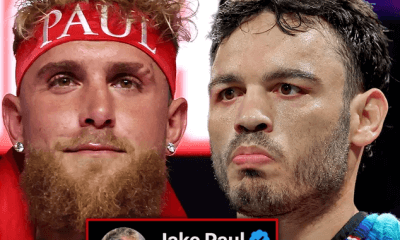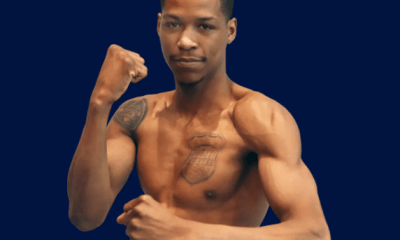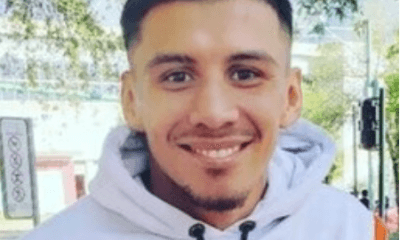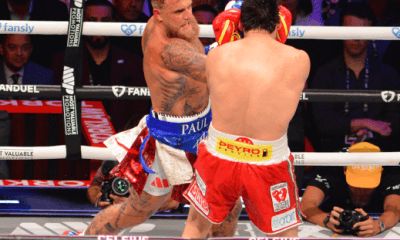Featured Articles
A Cornucopia of Heavyweights: Joshua-Usyk in the Vanguard
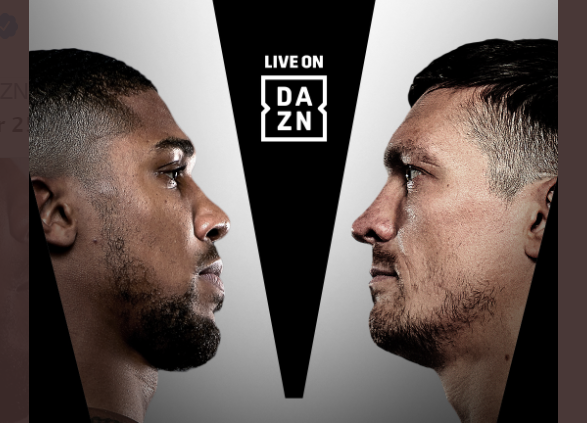
The eyes of the boxing world will be focused on North London this Saturday where WBA/IBF/WBO heavyweight champion Anthony “AJ” Joshua risks his belts against Oleksandr Usyk. The venue is new Tottenham Hotspur Stadium which seats 62,303 and there won’t be an empty seat in the joint.
Both were gold medalists at the 2012 Olympic Games in London by virtue of out-pointing Italian veterans in their final match. Joshua (24-1, 22 KOs as a pro) won a razor-thin decision over Roberto Cammarelle. Usyk (18-0, 13 KOs) won a narrow decision over Clemente Russo, avenging a loss to Russo in the 2008 Games in Beijing.
AJ last fought on Dec. 12 of last year. He knocked out Kubrat Pulev in the ninth round before a pandemic-restricted crowd of 1,000 at Wembley Arena. Prior to that, he avenged his lone defeat with a wide 12-round decision over poorly-conditioned Andy Ruiz in Diriyah, Saudi Arabia.
Usyk’s last fight was also a closed-door affair at Wembley. In October of last year, he out-pointed Dereck Chisora. It was Usyk’s second fight as a heavyweight. Chisora out-weighed him by 38 pounds.
Usyk won a clear unanimous decision, but never seriously hurt his bigger opponent. “Physically he’s not that strong,” said Chisora after the fight. “I ate one of his best shots and it didn’t bother me…He’s a good mover, that’s it.”
All things being equal, goes an old saying, bigger beats smaller. AJ has slimmed down since his last outing but will still enjoy a substantial weight advantage. Moreover, although Usyk is a southpaw, it’s worth noting that Joshua’s most spectacular showing came against a lefty, namely Charles Martin who he whacked out in the second round.
At last glance, Anthony Joshua was a consensus minus-270 favorite. We have no interest in laying it.
Oleksandr Usyk is more than a good mover. In the footwork department, he’s a bigger version of stablemate Vasiliy Lomachenko. His signature win was a near-shutout over Russian knockout-artist Murat Gassiev at Moscow in a match that on paper was a 50-50 proposition. Usyk’s showing against the previously undefeated Gassiev was “a performance of jaw dropping brilliance” in the words of Matt McGrain.
Anthony Joshua, three years younger at age 31, will have the home-field advantage. But for whatever it’s worth, the Ukrainian is undefeated on British soil: 8-0 as an amateur, 2-0 as a pro, and 1-0 in the semi-pro World Series of Boxing. Way back in 2013, Usyk flummoxed Joe Joyce in a 5-round contest at London’s venerable York Hall.
Joshua vs. Usyk will air on Sky Sports PPV in the UK and will be live-streamed on DAZN to more than 170 countries around the world. First bell figures to go about 2:15 pm for viewers in the Pacific Time Zone
—
A strong undercard will augment the trilogy fight between Tyson Fury and Deontay Wilder at the T-Mobile Arena in Las Vegas on Oct. 9. Two heavyweight fights are especially intriguing.
Adam Kownacki (20-1, 15 KOs) meets Robert Helenius (30-3, 19 KOs) in a rematch. Neither has had an intervening fight since they locked horns at Barclays Center in Brooklyn in March of last year.
Kownacki, born in Poland but a resident of Brooklyn since the age of seven, was the house fighter at Barclays. This was his tenth appearance there and he had developed a strong local following.
After three rounds, Kownacki was well-positioned to keep his undefeated record intact. He was ahead on the scorecards and there was the presumption that Helenius, who was getting long in the tooth, would run out of gas as had happened in his previous fight in the U.S. when he was stopped in the eighth round by former Kownacki victim Gerald Washington. But in Round 4, Helenius, a Finn, lived up to his nickname “Nordic Nightmare.”
A right-left combination put Kownacki on the canvas. The referee incorrectly ruled it a slip although he was clearly buzzed. When he got to his feet, Helenius dropped him again. Kownacki was up in a jiff but looked as if it would take only a stiff wind to knock him off his pins once again. The referee wisely waived it off.
Kownacki, who makes up for his doughboy-like physique and defensive limitations with a high workrate, has been training in Florida and expects to come in significantly lighter than he did for Helenius where he tipped the scales at 265 pounds. The six-foot-seven Helenius, now 37 years old, has been impersonating Tyson Fury at Deontay Wilder’s camp in Alabama and figures to be in good shape.
The pricemakers think Adam Kownacki will avenge his lone defeat. At last look, he was a 14/5 favorite.
—
The 10-round “special attraction between Frank Sanchez and Efe Ajagba is that all-too-rare crossroads fight matching undefeated boxers at the same stage of their development. Sanchez, the 29-year-old Miami-based Cuban defector, is 18-0 with 13 KOs; Ajagba, the 27-year-old Houston-based Nigerian is 15-0 (12). And physically, they are about the same. At six-foot-six, Ajagba is two inches taller and will likely carry a few more pounds.
Ajagba entered the pro ranks with considerably more fanfare. His first pro trainer, Ronnie Shields, a man not given to hyperbole, compared him to the young George Foreman and proclaimed him a surefire world champion. (Ajagba is now with Kay Koroma who also trains hot heavyweight prospect Jared Anderson.)
Frank Sanchez was the more polished product coming out of the amateur ranks; he’s considered a better boxer than Ajagba and is also capable of taking a man out with one punch. However, when this reporter saw the odds (the Cuban is currently favored by odds as high as 9/4), he did a double-take. Is this the right favorite? Or was the pricemaker swayed by the report that Sanchez was 214-6 as an amateur (BoxRec shows 43-12)?
Here’s the caveat: I have seen and read a lot more about Ajagba than about Frank Sanchez. It would be arrogant of me to think that I know more than the fellow that formulated the opening odds.
What’s tempting is to put a flyer on both underdogs, separate bets on Helenius and Ajagba. A split seems reasonable and that would translate into a small profit.
—
The latest heavyweight match to be announced pairs Otto Wallin against Dillian Whyte at the O2 Arena in London on Oct. 30. This too is a very intriguing fight.
A 30-year-old Swede who trains in New York under Joey Gamache, Otto Wallin is best known for giving Tyson Fury a tough tussle when they met two years ago at the T-Mobile Arena in Las Vegas. Wallin lost a unanimous decision but certainly had his moments and left the Gypsy King with quite a souvenir: a cut over his right eye that required 47 stitches. Wallin has fought twice since that event, stopping Travis Kauffman in the fifth frame and winning a unanimous decision over Dominic Breazeale, advancing his record to 22-1 (14).
Dillian Whyte (28-2, 19 KOs) needs no introduction. The Londoner by way of Jamaica has been a perennial top contender who presumably has pocketed a lot of dough these last few years in “step-aside” money.
Whyte opened a 5/2 favorite. We will have more to say about this fight as it draws closer to post time.
Check out more boxing news on video at the Boxing Channel
To comment on this story in the Fight Forum CLICK HERE
-

 Featured Articles3 weeks ago
Featured Articles3 weeks agoAvila Perspective, Chap. 330: Matchroom in New York plus the Latest on Canelo-Crawford
-

 Featured Articles2 weeks ago
Featured Articles2 weeks agoVito Mielnicki Jr Whitewashes Kamil Gardzielik Before the Home Folks in Newark
-

 Featured Articles4 weeks ago
Featured Articles4 weeks agoOpetaia and Nakatani Crush Overmatched Foes, Capping Off a Wild Boxing Weekend
-

 Featured Articles3 weeks ago
Featured Articles3 weeks agoCatching Up with Clay Moyle Who Talks About His Massive Collection of Boxing Books
-

 Featured Articles4 weeks ago
Featured Articles4 weeks agoFabio Wardley Comes from Behind to KO Justis Huni
-

 Featured Articles2 weeks ago
Featured Articles2 weeks agoMore Medals for Hawaii’s Patricio Family at the USA Boxing Summer Festival
-

 Featured Articles3 weeks ago
Featured Articles3 weeks agoThe Shafting of Blair “The Flair” Cobbs, a Familiar Thread in the Cruelest Sport
-

 Featured Articles3 weeks ago
Featured Articles3 weeks agoRichardson Hitchins Batters and Stops George Kambosos at Madison Square Garden



